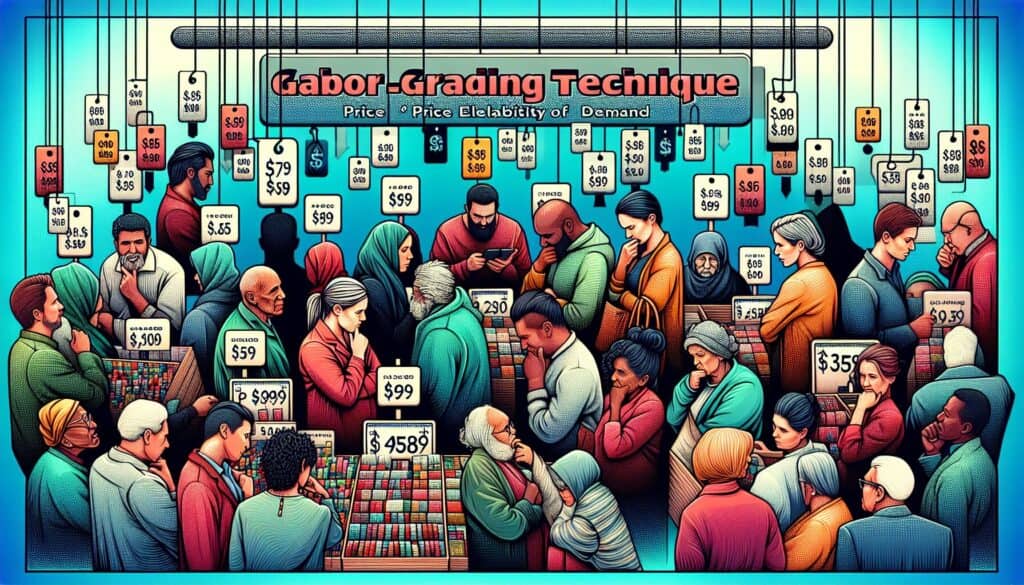Determinar la elasticidad-precio de la demanda de un producto preguntando a los clientes potenciales su probabilidad de compra a distintos precios.
- Metodologías: Clientes y marketing, Economía, Diseño de producto
Técnica de fijación de precios de Gabor-Granger

Técnica de fijación de precios de Gabor-Granger
- Experiencia del cliente, Estudios de mercado, Gestión de productos, Precios de los productos
Objetivo:
Cómo se utiliza:
- Se muestra un producto a los encuestados y se les pregunta si lo comprarían a un precio determinado. En caso afirmativo, se sube el precio; en caso negativo, se baja (o se presenta una serie aleatoria de precios). Esto continúa durante varios puntos de precio para crear una curva de demanda.
Ventajas
- Mide directamente la disposición a comprar a precios específicos, ayuda a estimar los ingresos y el potencial de beneficios a distintos niveles de precios, relativamente fácil de aplicar en las encuestas.
Contras
- La intención de compra hipotética puede no reflejar el comportamiento de compra real, no tiene en cuenta explícitamente las acciones de la competencia o las alternativas de producto en el cuestionario.
Categorías:
- Clientes y marketing, Economía
Ideal para:
- Estimación de la demanda y los ingresos potenciales de un producto a distintos precios específicos.
The Gabor-Granger Pricing Technique is particularly effective in various stages of product development and marketing strategies across several industries including consumer goods, technology, and pharmaceuticals. This methodology can be especially beneficial during the product ideation and prototype testing phases, where understanding customer sentiment towards pricing can lead to informed design and marketing decisions. Key participants in this technique typically include product managers, market researchers, and pricing strategists, who together analyze customer responses to shape pricing strategies that align with perceived value. For instance, in the technology sector, companies launching new devices can employ this method to gauge how potential customers respond to different price points, allowing them to optimize pricing strategies right before launch. The healthcare industry often employs this technique in market research for new drugs or medical devices, where it is critical to understand pricing dynamics to ensure market access and reimbursement. The simplicity of this method allows organizations to gather quantifiable data efficiently through surveys and online platforms, which can be rapidly analyzed to generate demand curves, thus providing actionable insights that can adapt to different segments and preferences. By incorporating demographic factors or psychographic profiles, firms can segment responses, allowing for targeted pricing strategies that cater specifically to identified consumer bases, enhancing revenue potential while also refining product offerings based on real market data. This adaptability makes the Gabor-Granger approach a versatile tool for organizations navigating multiple market uncertainties.
Pasos clave de esta metodología
- Show respondents a product along with an initial price point.
- Ask respondents if they would purchase the product at that price.
- If yes, increase the price in the next iteration; if no, decrease the price.
- Repeat this process for a series of price points to map demand.
- Analyze the responses to construct a demand curve based on willingness to buy.
Consejos profesionales
- Conduct sensitivity analysis to understand how variations in pricing affect demand elasticity, refining your price ranges accordingly.
- Incorporate psychographic factors into your survey design to capture deeper motivations and psychological pricing thresholds of different segments.
- Iterate on the pricing experiments by utilizing A/B testing methodologies to identify the most effective price points in real-time settings.
Leer y comparar varias metodologías, recomendamos el
> Amplio repositorio de metodologías <
junto con otras más de 400 metodologías.
Sus comentarios sobre esta metodología o información adicional son bienvenidos en la dirección sección de comentarios ↓ , así como cualquier idea o enlace relacionado con la ingeniería.
Contexto histórico
1960
1980
1983
1990
1995
2000
2010
1950
1980
1980
1986
1994
1995
2000
(si se desconoce la fecha o no es relevante, por ejemplo "mecánica de fluidos", se ofrece una estimación redondeada de su notable aparición)














Publicaciones relacionadas
Programa Maestro de Producción (MPS)
Personalización masiva
Embudo de marketing
Auditoría de marketing
Índice MAPO (Movimiento y Asistencia de Pacientes Hospitalizados)
Planificación de recursos de fabricación (MRP II)